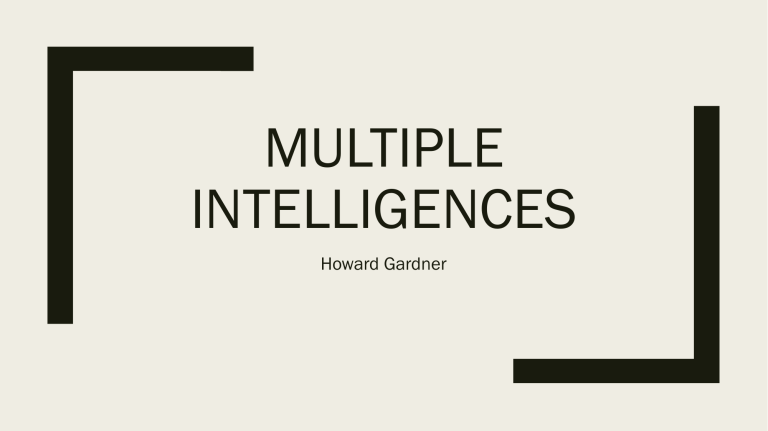
MULTIPLE INTELLIGENCES Howard Gardner Difference Between MI and LS LS is how one approaches a range of tasks. MI is one’s intellectual ability (strongest area of intelligence). Different Intelligences 1. Verbal-linguistic intelligence (well-developed verbal skills and sensitivity to the sounds, meanings and rhythms of words) 2. Logical-mathematical intelligence (ability to think conceptually and abstractly, and capacity to discern logical and numerical patterns) 3. Spatial-visual intelligence (capacity to think in images and pictures, to visualize accurately and abstractly) 4. Bodily-kinesthetic intelligence (ability to control one’s body movements and to handle objects skillfully) 5. Musical intelligences (ability to produce and appreciate rhythm, pitch and timber) 6. Interpersonal intelligence (capacity to detect and respond appropriately to the moods, motivations and desires of others) 7. Intrapersonal (self-aware and in tune with inner feelings, values, beliefs and thinking processes) Newest 8. Naturalist intelligence (ability to recognize and categorize plants, animals and other objects in nature) 9. Existential intelligence (sensitivity and capacity to tackle deep questions about human existence such as, What is the meaning of life? How did we get here? ) Challenges An educational system assumes all learn the same materials in the same way and a uniform, universal measure suffices to test learning. Our educational system is biased toward linguistic modes of instruction and assessment and toward logical-quantitative modes as well. Students learn in ways that are distinctive. The broad spectrum of students would be better served if disciplines could be presented in a numbers of ways and learning could be assessed through a variety of means. Linguistic: Using words effectively These learners have highly developed auditory skills and often think in words. They like reading, playing word games, making up poetry or stories. They can be taught by encouraging them to say and see words, read books together. Tools include computers, games, multimedia, books, tape recorders, and lecture. Logical-Mathematical: Reasoning, calculating Think conceptually, abstractly and are able to see and explore patterns and relationships. They like to experiment, solve puzzles, ask cosmic questions. They can be taught through logic games, investigations, mysteries. They need to learn and form concepts before they can deal with details. Visual-Spatial Thinking in terms of physical space Architects and sailors. Very aware of their environments. They like to draw, do jigsaw puzzles, read maps, daydream. They can be taught through drawings, verbal and physical imagery. Tools include models, graphics, charts, photographs, drawings, 3-D modeling, video, videoconferencing, television, multimedia, texts with pictures/charts/graphs. Bodily-Kinesthetic Using body effectively A dancer or a surgeon. Keen sense of body awareness. They like movement, making things, touching. They communicate well through body language and be taught through physical activity, hands-on learning, acting out, role playing. Tools include equipment and real objects. Musical Sensitivity to rhythm and sound They love music, but they are also sensitive to sounds in their environments. They may study better with music in the background. Can be taught by turning lessons into lyrics, speaking rhythmically, tapping out time. Tools include musical instruments, music, radio, stereo, CD-ROM, multimedia. Interpersonal Understanding, interacting with others They have many friends, empathy for others, street smarts. They can be taught through group activities, seminars, dialogues. Tools include the telephone, audio conferencing, time and attention from the instructor, video conferencing, writing, computer conferencing, social media. Intrapersonal Understanding one's own interests, goals They're in tune with their inner feelings; they have wisdom, intuition and motivation, as well as a strong will, confidence and opinions. They can be taught through independent study and introspection. Tools include books, creative materials, diaries, privacy and time. They are the most independent of the learners. Activity Examine your learning style and multiple intelligence(s): http://literacynet.org/mi/assessment/findyourstrengths .html How are do they complement each other? How are they different? What are your favorite ways to learn?


